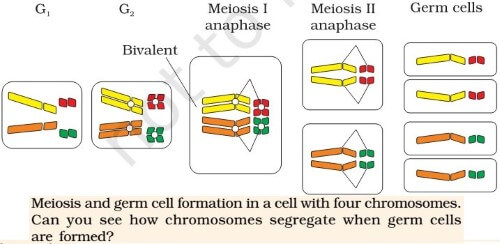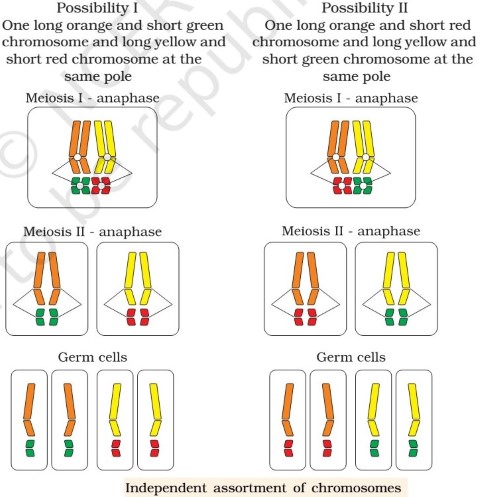Chromosomal Theory of Inheritance
- Due to advancements in microscopy during 1900s, scientists were able to observe cell division. This led to the discovery of structures in the nucleus that appeared to double and divide just before each cell division. These were called chromosomes (colored bodies, as they were visualised by staining).
- By 1902, the chromosome movement during meiosis had been worked out. The behavior of chromosomes was parallel to the behavior of genes and used biologists used chromosome movement to explain Mendel’s laws.
[Mitosis (equational division) and meiosis (reduction division) were explained in previous posts].
- The important things to remember are that chromosomes as well as genes occur in pairs. The two alleles of a gene pair are located on homologous sites on homologous chromosomes.
- During Anaphase of meiosis I, the two chromosome pairs can align at the metaphase plate independently of each other.
- To understand this, compare the chromosomes of four different colour in the left and right columns. In the left column (Possibility I) orange and green is segregating together. But in the right hand column (Possibility II) the orange chromosome is segregating with the red chromosomes.
- Sutton and Boveri argued that the pairing and separation of a pair of chromosomes would lead to the segregation of a pair of factors they carried. Sutton united the knowledge of chromosomal segregation with Mendelian principles and called it the chromosomal theory of inheritance.
- Following this synthesis of ideas, experimental verification of the chromosomal theory of inheritance by Thomas Hunt Morgan and his colleagues, led to discovering the basis for the variation that sexual reproduction produced.
- Morgan worked with the tiny fruit flies, Drosophila melanogaster, which were found very suitable for such studies.
Linkage and Recombination
- Morgan carried out several dihybrid crosses in Drosophila to study genes that were sex-linked. The crosses were similar to the dihybrid crosses carried out by Mendel in peas.
- For example Morgan hybridised yellow-bodied, white-eyed females to brown-bodied, red-eyed males and intercrossed their F 1 progeny. He observed that the two genes did not segregate independently of each other and the F 2 ratio deviated very significantly from the 9:3:3:1 ratio (expected when the two genes are independent).
- Morgan and his group knew that the genes were located on the X chromosome and saw quickly that when the two genes in a dihybrid cross were situated on the same chromosome, the proportion of parental gene combinations were much higher than the non-parental type.
- Morgan attributed this due to the physical association or linkage of the two genes and coined the term linkage to describe this physical association of genes on a chromosome and the term recombination to describe the generation of non-parental gene combinations.
- Alfred Sturtevant used the frequency of recombination between gene pairs on the same chromosome as a measure of the distance between genes and ‘mapped’ their position on the chromosome.
- Today genetic maps are extensively used as a starting point in the sequencing of whole genomes as was done in the case of the Human Genome Sequencing Project.
Human Genome Project
- Human Genome Project is a publicly funded international collaborative scientific research project aimed at determining the sequence of chemical base pairs which make up human DNA, and of identifying and mapping all of the genes of the human genome.
[A base pair (bp) is a unit consisting of two nucleobases bound to each other by hydrogen bonds. They form the building blocks of the DNA double helix, and contribute to the folded structure of both DNA and RNA.]
- Human Genome Project was formally launched in 1990, and finally declared complete in 2003.
- The “genome” of any given individual is unique; mapping “the human genome” involves sequencing multiple variations of each gene.
- All our genes together are known as our ‘genome.’ The HGP has revealed that there are probably about 20,500 human genes.
Applications and Benefits of Human Genome Project
Can help us
- understand diseases including: genotyping of specific viruses to direct appropriate treatment,
- in identification of mutations linked to different forms of cancer,
- understand the design of medication and more accurate prediction of their effects,
- in advancement of forensic applied sciences, biofuels and other energy applications, agriculture, animal husbandry, etc..
- understand evolution much more accurately.
- Another proposed benefit is the commercial development of genomics research related to DNA based products, a multibillion-dollar industry.
Summary
- After knowing that the genes are located on the chromosomes, a good correlation was drawn between Mendel’s laws: segregation and assortment of chromosomes during meiosis. The Mendel’s laws were extended in the form of ‘Chromosomal Theory of Inheritance’.
- Later, it was found that Mendel’s law of independent assortment does not hold true for the genes that were located on the same chromosomes. These genes were called as ‘linked genes’.
- Closely located genes assorted together, and distantly located genes, due to recombination, assorted independently. Linkage maps, therefore, corresponded to arrangement of genes on a chromosome.
- Many genes were linked to sexes also, and called as sex-linked genes. The two sexes (male and female) were found to have a set of chromosomes which were common, and another set which was different.
- The chromosomes which were different in two sexes were named as sex chromosomes. The remaining set was named as autosomes. In humans, a normal female has 22 pairs of autosomes and a pair of sex chromosomes (XX).
- Human Genome Project is a collaborative scientific research project aimed at identifying and mapping all of the genes of the human genome.
- Human genome project is helpful in wide ranging biotechnology applications.





0 Comments